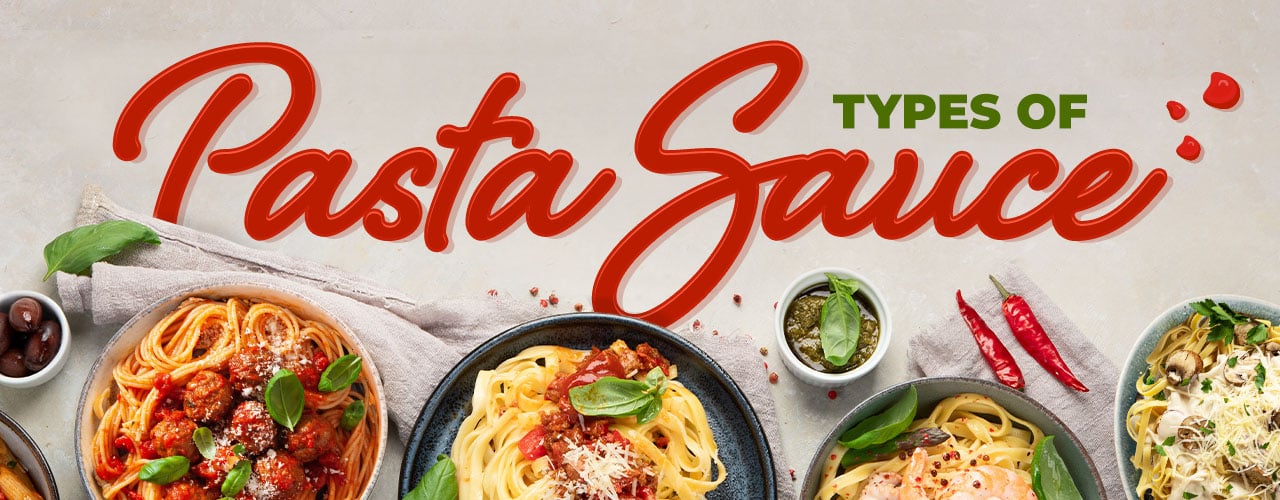
Types of Pasta Sauce
Last updated on 8/18/2022Pasta is a celebrated dish, with the versatility that allows you to build whole menu concepts around it. But with hundreds of types of pasta to choose from, narrowing down the type of pasta sauce you’ll want to use can be a challenge. We’ll help you curate a delicious menu by explaining the 12 most popular types of pasta sauces along with which pasta noodles pair best with each. Click the following link to check out our printable pasta sauce chart.
Shop All Pasta SaucesTypes of Pasta Sauce
Whether you’re looking for traditional tomato-based options or rich and creamy decadent sauces, we’ve compiled a list of different pasta sauces you can use on your menu to create pasta dishes your customers will love.
1. Marinara Sauce

Marinara is a herbaceous, tomato-based sauce and one of the most common pasta sauce types. Originally used by Italian fishermen, this simple sauce was poured atop freshly caught fish after a long day’s work. The marinara sauce that most are familiar with today is more of an Italian-American rendition than the "mariner-style" sauce that was used back in the day. Because marinara pasta sauce has relatively few ingredients, it can be used as the base of other more complex sauces. It is often mistaken for pizza sauce since both are tomato based and slightly chunky in consistency.
- Best Pasta for Marinara Sauce: Spaghetti, Lasagna, Linguini, Penne
- What Goes With Marinara Sauce? Beef, sausage, chicken, peppers, onion, broccoli, garlic bread
- What Wine Goes With Marinara Sauce? Medium- To Full-Bodied Red Wine
- Recipes With Marinara Sauce: Spaghetti and meatballs, Lasagna, Chicken parmesan, dipping sauce for mozzarella sticks or on sandwiches
How to Make Marinara Sauce
To make marinara sauce, you’ll need crushed tomatoes, diced onions, garlic, and Italian herbs. This sauce is relatively simple and can be prepared in around 20-30 minutes. Because of its simplicity, ingredients like capers, olives, and wine are often added.
- Heat olive oil in a saucepan.
- Saute the diced onion and garlic until fragrant.
- Add the tomatoes, herbs, salt, and pepper (to taste). Allow to simmer partially covered for 15-20 minutes.
- Remove from heat and serve over pasta of choice.
2. Alfredo Sauce
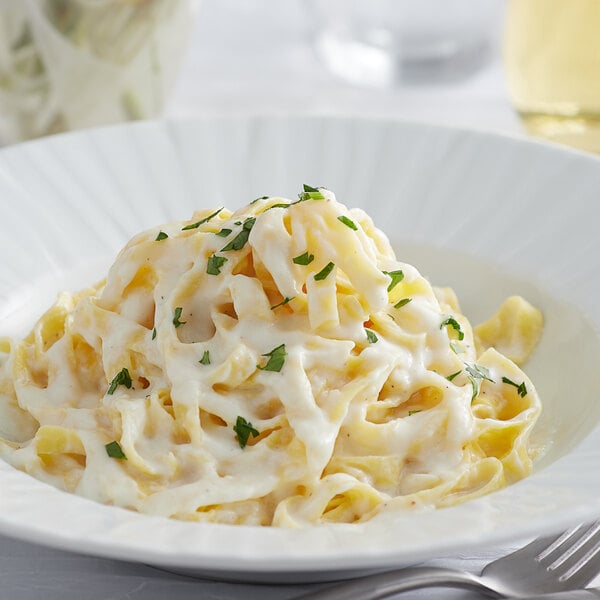
Alfredo sauce is a rich and creamy white sauce that is most often paired with fettuccine noodles. This sauce was created in 1914 by restaurateur Alfredo Di Lelio in Rome. The original sauce was a combination of butter and melted cheese, but now features cream and occasionally flour that allows it to coat the noodles more evenly. Alfredo pasta sauce isn’t for the health-conscious but it does make a delicious addition to any pasta menu. Offer chilled white wine during your wine service to complement this rich sauce.
- Best Pasta for Alfredo Sauce: Fettuccine, Linguine, Pappardelle, Shells
- What Goes With Alfredo Sauce? Chicken, shrimp, bacon, peas, broccoli, asparagus, garlic bread, Caesar side salad
- What Wine Goes With Alfredo Sauce? Fruit Dry White Wine
- Recipes With Alfredo Sauce: Fettuccine alfredo with chicken or shrimp, Baked pasta, Stuffed shells, Alfredo canapes appetizers, Chicken alfredo dip
How to Make Alfredo Sauce
To prepare alfredo sauce, most recipes will call for butter, heavy whipping cream, minced garlic, Italian seasoning, and Parmesan cheese. Some chefs like to add cream cheese and flour for added decadence.
- Start by melting the butter in a pan on medium-low heat.
- Whisk in the cream and let simmer for 5 minutes.
- Stir in the garlic, Italian seasoning, and cheese before serving.
3. Bolognese Sauce
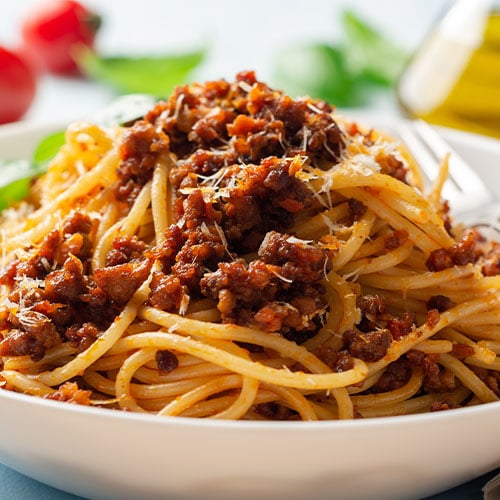
Bolognese sauce, pronounced "bow-luh-nayz", is a type of ragu sauce made with meat. Despite its red appearance, this sauce is actually meat-based and not tomato-based, with tomatoes being a very small addition to the recipe. Its name comes from its origin city of Bologna, where ragu alla bolognese became a staple in the 18th century. With some variations, it is now a more popular spaghetti sauce in the U.S. than in Italy amongst meat lovers. This hearty sauce pairs well with a glass of red wine.
- Best Pasta for Bolognese Sauce: Tagliatelle, Fettuccine, Spaghetti, Rigatoni
- What Goes With Bolognese Sauce? Beef, sausage, potatoes, peppers, asparagus, zucchini, carrots
- What Wine Goes With Bolognese Sauce? Medium-Bodied Red Wine
- Recipes With Bolognese Sauce: Spaghetti bolognese, Baked ziti, Stuffed peppers, Bolognese pasta bake, Lasagna
Ragu vs Bolognese
The difference between ragu and bolognese is that ragu is a meat-based sauce while bolognese is a type of ragu. Traditional ragu pasta sauce is made with a variety of ground proteins, such as veal, beef, pork, and lamb, cooked in red wine. Bolognese also features an array of ground meats, such as chicken, veal, and even horsemeat, but they are cooked in white wine instead.
How to Make Bolognese Sauce
To make bolognese pasta sauce, you’ll first want to narrow down your protein of choice. This sauce can feature more than one ground meat, making it a hearty option for your menu. You will also need white wine, tomatoes, butter, mirepoix, milk, and seasonings.
- Heat oil and butter in a pan before adding your onions, cooking until translucent.
- Add the celery and carrots to the pan and cook for another 2 minutes.
- Add the ground meats and seasonings to the pan, and cook until no longer pink.
- Pour in the wine and let simmer until evaporated.
- Stir in the milk, and let simmer.
- Finally, add in the tomatoes and let the sauce simmer for around 3-5 hours.
- Serve with pasta and parmesan cheese.
4. Vodka Sauce
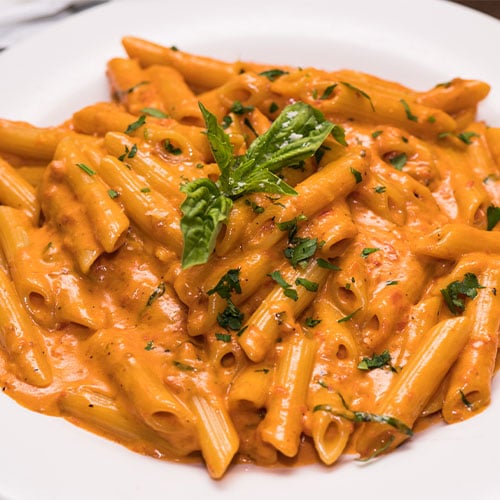
Vodka sauce has a distinct reddish-pink color that is caused by the alcohol in vodka interacting with the acidity of the tomatoes. It is both creamy and tangy, making it a good alternative to alfredo and marinara sauce. Vodka pasta sauce was created in the 1980s, but it’s unclear who was the original inventor, Columbia University student James Doty or New York-based chef Luigi Franzese. The sauce uses a splash of vodka to caramelize the tomatoes, adding a rich level of complexity to the dish that foodies will love.
- Best Pasta for Vodka Sauce: Penne, Rigatoni, Rotini, Bow tie, Orecchiette
- What Goes With Vodka Sauce? Italian sausage, chicken, shrimp, brussels sprouts, broccoli, garlic bread
- What Wine Goes With Vodka Sauce? Light-Bodied Red Wine
- Recipes With Vodka Sauce: Penne alla vodka, Vodka sauce pizza, Italian sausage and vodka sauce spaghetti
How to Make Vodka Sauce
Vodka sauce is quite simple to prepare. To make vodka pasta sauce, you’ll need heavy cream, tomato paste, peeled tomatoes, garlic, butter, oil, onions, parmesan, and vodka.
- Saute your onion and garlic over medium heat.
- Add in the tomato paste and peeled tomato, stirring for 5-10 minutes until deep red.
- Add in your vodka and simmer for 20 minutes.
- Blend your ingredients in a food processor until smooth.
- Return the ingredients to the pan and add heavy cream and cheese, heating for 2-3 minutes before serving.
5. Pomodoro Sauce

Pomodoro pasta sauce is a highly traditional tomato sauce and is considered one of the first pasta sauces to be invented. “Pomodoro” is the Italian word for tomato or “golden apple”, which is the primary ingredient of this pasta sauce. Pomodoro sauce was officially documented in 1837 when chef Ippolito Cavalcanti added it to his recipe book, turning it into a national sensation. This light tomato sauce is perfect for any spaghetti dinner.
- Best Pasta for Pomodoro Sauce: Spaghetti, Rigatoni, Angel hair, Penne, Gnocchi
- What Goes With Pomodoro Sauce? Chicken, shrimp, sun-dried tomatoes, pepper, zucchini, squash
- What Wine Goes With Pomodoro Sauce? Fruit Dry White Wine
- Recipes With Pomodoro Sauce: Spaghetti al Pomodoro, Spinach and zucchini rigatoni, Chicken pomodoro
Pomodoro vs Marinara Sauce
Despite having very similar ingredients, the difference between marinara and Pomodoro sauce is their texture and consistency. Pomodoro sauce is thicker but smoother than marinara sauce, which is usually more water due to the tomato chunks in the recipe.
How to Make Pomodoro Sauce
You’ll need tomatoes, garlic, extra virgin olive oil, fresh basil, and salt to make Pomodoro sauce. This spaghetti sauce is simple and straightforward.
- Start by sauteing your garlic in olive oil.
- Add whole peeled tomatoes to the pot and simmer until they are soft.
- Use an immersion blender to puree the tomatoes until smooth.
- Add basil and serve.
6. Pesto Sauce
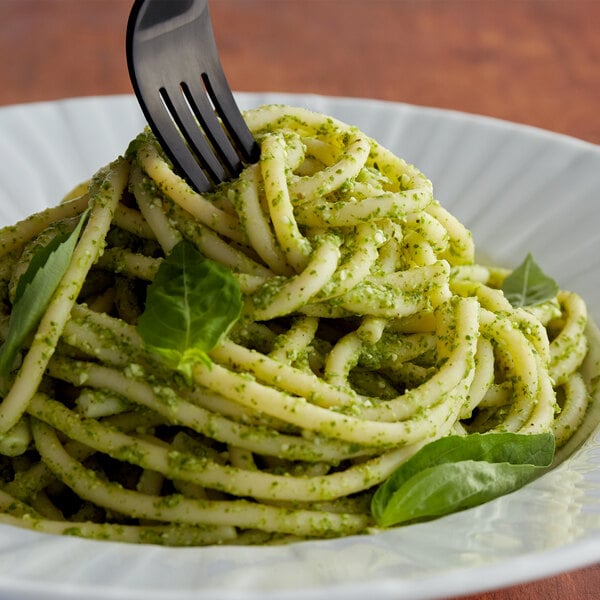
Pesto sauce is a bright green basil-based pasta sauce that doesn’t require any cooking to prepare. This light sauce originates from Genoa, Italy, and is often used on pasta, sandwiches, and salads. Once made, pesto pasta sauce can be stored in the refrigerator and dished out as needed. The flavor will intensify after a few days, creating a more delicious and herbaceous sauce for your dishes. Pesto usually contains pine nuts so it is important to put an allergy warning on your menu for customers with nut allergies.
- Best Pasta for Pesto Sauce: Farfalle, Rotini, Fusilli, Bow tie, Spaghetti
- What Goes With Pesto Sauce? Chicken, salmon, green beans, red peppers, broccoli, carrots, beans, mozzarella
- What Wine Goes With Pesto Sauce? Dry White Wine
- Recipes With Pesto Sauce: Pesto pasta with shrimp or chicken, Chicken Caprese sandwich, Salad dressing, Pesto garlic bread
How to Make Pesto Sauce
Pesto is made with basil leaves, pine nuts, extra-virgin olive oil, and Parmigiano-Reggiano.
- Crush the pine nuts first, using a mortar and pestle or food processor.
- Add the garlic in and blend to make a fine paste.
- Throw in wet basil leaves and blend in.
- Add the Parmigiano-Reggiano and oil, a little at a time while mixing.
- Serve on cooked pasta or spread over bread.
7. Carbonara Sauce
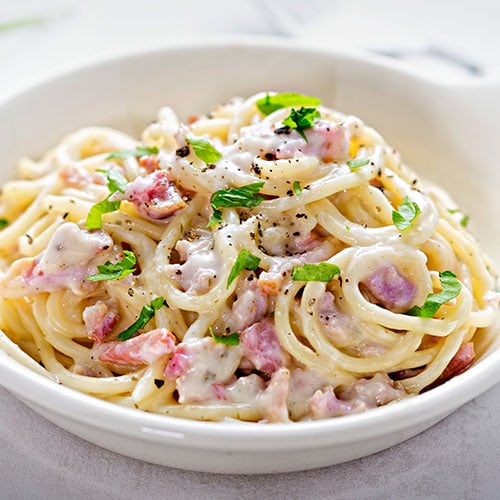
Carbonara sauce is a rich and creamy pasta sauce, often paired with bacon and peas. The key feature that sets carbonara pasta sauce apart from the rest is the inclusion of an egg. The egg allows the sauce to stick and coat the pasta pieces evenly. There is great debate about the right way to make carbonara sauce: whether a whole egg or just the yolk should be used, when it should be added, and whether you should use bacon vs pancetta. This sauce gained popularity during World War II, as it could be made with rations that didn’t need to be refrigerated.
- Best Pasta for Carbonara Sauce: Spaghetti, Rigatoni, Linguine, Angle Hair
- What Goes With Carbonara Sauce? Bacon, scallops, peas, zucchini, spinach, caesar side salad, bruschetta
- What Wine Goes With Carbonara Sauce? Light-Bodied Red Wine
- Recipes With Carbonara Sauce: Spaghetti carbonara, Carbonara sauce meatballs, Chicken carbonara casserole, Carbonara pizza
Carbonara vs Alfredo
The difference between alfredo and carbonara is that carbonara contains an egg while alfredo sauce does not. Carbonara is usually thinner in consistency than alfredo sauce, using the egg to coat the noodles instead of relying on the cream. Both sauces are cream-based and contain large quantities of shredded cheese to make them rich and decadent.
How to Make Carbonara Sauce
For this version of carbonara sauce, you’ll need egg yolks, pancetta, peas, parmesan cheese, cream, and butter.
- Cook and set aside your pasta.
- Saute the pancetta in the butter until crispy.
- In a separate bowl, mix the egg yolks, cheese, and a little cream or milk.
- On medium heat, add the peas and some pasta water to the pancetta.
- Scoop the pasta into the pan with the pancetta and mix.
- Turn the temperature on low and pour in the egg mixture, stirring until the pasta is fully coated.
8. Bechamel Sauce
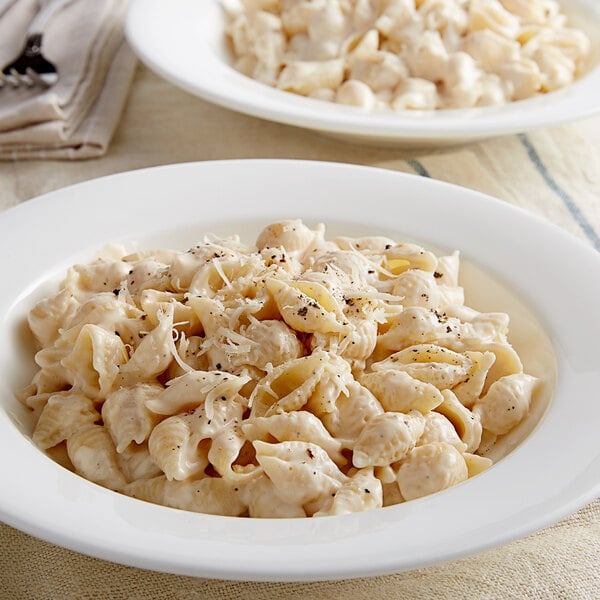
Bechamel sauce, pronounced "bay-shuh-mel", is cream-based and one of the five mother sauces. Included in chef Auguste Escoffier’s list of foundational sauces, bechamel sauce is the base of almost all cheese sauces. Bechamel has Italian origins but gained popularity in France after it was introduced to the court of King Louis XIV. This relatively simple white sauce, made with milk and roux, is creamy and velvety, making it perfect for pasta and sandwiches.
- Best Pasta for Bechamel Sauce: Macaroni, Penne, Spaghetti, Cavatappi
- What Goes With Bechamel Sauce? Shrimp, scallops, bacon, ground beef, carrots, peppers, broccoli
- What Wine Goes With Bechamel Sauce? Dry White Wine
- Recipes With Bechamel Sauce: Macarona bechamel, Spaghetti and white sauce, Bechamel pasta bake, Croque monsieur, Lasagna
Bechamel vs Alfredo
Although they look similar, the difference between bechamel and alfredo sauce is their ingredients. While bechamel sauce is made with milk and flour, alfredo sauce is mainly made with heavy cream and cheese. Both have a creamy texture that thoroughly coats pasta noodles, but bechamel tends to be thicker than alfredo sauce.
How to Make Bechamel Sauce
To make bechamel sauce, you’ll need butter, flour, whole milk, nutmeg, and salt.
- Melt your butter over medium heat.
- Add the flour, mixing until smooth.
- Allow the sauce to cook for approximately 7 minutes while stirring.
- Once it turns a light sand color, turn the heat to medium-high and whisk in the milk until it thickens.
- Allow the sauce to simmer on medium-low heat for 10-20 minutes.
- Season with salt and nutmeg before serving.
9. Arrabiata Sauce
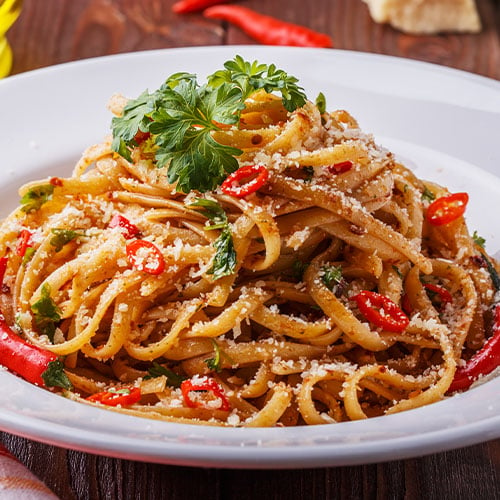
Arrabbiata sauce, more commonly spelled as arrabiata sauce and pronounced "aa-raa-bee-aa-tuh", is a spicy tomato-based spaghetti sauce. This sauce originates from the Lazio region in Rome and is traditionally made with in-season tomatoes and red chili peppers. Arrabiata sauce brings some heat to your signature dishes and pairs well with a glass of red wine or rose wine. Just be sure to test your recipe regularly to keep it from getting too spicy.
- Best Pasta for Arrabiata Sauce: Penne, Spaghetti, Egg noodles, Rigatoni
- What Goes With Arrabiata Sauce? Shrimp, pork, chicken, garlic bread, asparagus, zucchini, mashed potatoes
- What Wine Goes With Arrabiata Sauce? Light-Bodied Red Wine
- Recipes With Arrabiata Sauce: Penne all’arrabbiata, Spaghetti and meatball arrabiata, Chicken arrabiata
Pomodoro vs Arrabiata
The difference between Pomodoro and arrabiata is that arrabiata contains red chili peppers and is spicy compared to the mild flavor of Pomodoro sauce. Both sauces are tomato based and incorporate garlic and Italian spices.
How to Make Arrabiata Sauce
To prepare arrabiata pasta sauce, you’ll need canned whole tomatoes, dried red chili pepper or chili flakes, oil or butter, onion, garlic, and basil.
- Heat your oil or butter in a large saucepan and toast the pepper for about two minutes.
- Add the garlic and onion to the pan and saute until the onion is translucent.
- In a separate bowl, crush the tomatoes until there are only a few small chunks.
- Add the tomatoes to the pot and simmer on a low flame for about an hour, stirring at 10-minute intervals, until the sauce thickens.
- Stir in the basil and serve.
10. Amatriciana Sauce
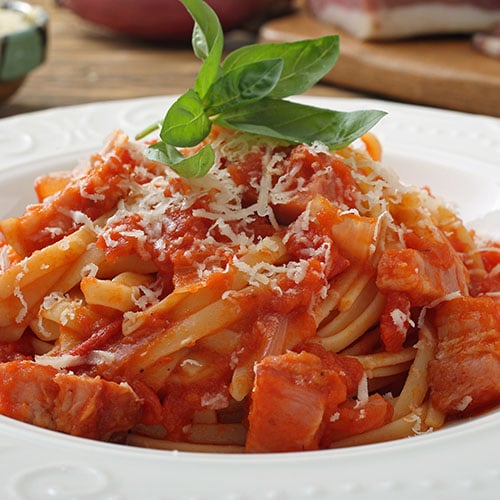
Amatriciana pasta sauce, pronounced "aa-muh-tree-chaa-nuh", is a savory tomato-based sauce, traditional to the town of Amatrice in Italy. The history of this sauce is so protected, that if certain DOP ingredients are not used, it cannot be considered amatriciana sauce. The sauce originates from the 18th century when Amatriciana shepherds would prepare a sauce from pecorino cheese and guanciale (pork jowl) when they traveled. This history-rich sauce is now one of the most popular in Roman cuisine.
- Best Pasta for Amatriciana Sauce: Bucatini, Spaghetti, Rigatoni, Ziti
- What Goes With Amatriciana Sauce? Guanciale, chicken, potatoes, olives, Brussel sprouts
- What Wine Goes With Amatriciana Sauce? Sparkling Wine
- Recipes With Amatriciana Sauce: Bucatini all'amatriciana, Amatriciana pizza, Chicken amatriciana traybake
How to Make Amatriciana Sauce
For a sauce to be considered amatriciana sauce, you must use guanciale, Pecorino Romano cheese, San Marzano tomatoes. You will also need white wine, pepper, oil, onion, and chili flakes. Some variations may use red wine in the place of white wine.
- Heat the oil over medium heat.
- Add the guanciale into the oil and brown until the fat is translucent.
- Saute the onion in the guanciale fat.
- Puree the San Marzano tomatoes.
- Stir in the tomato puree, cooking on low heat for 10-15 minutes.
- Add the Pecorino Romano cheese and season with pepper and chili flakes before serving.
11. Cacio e Pepe Sauce
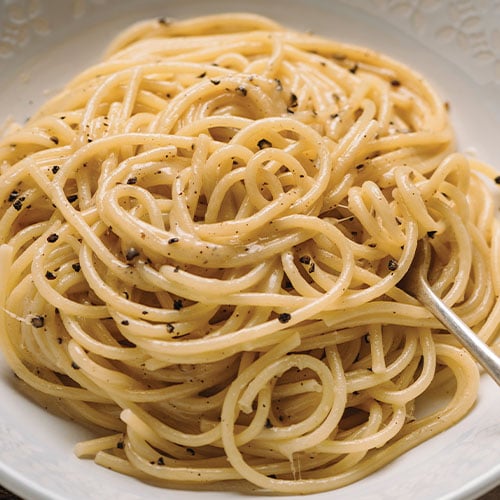
Cacio e pepe sauce, pronounced "kah-chee-ow ee peh-pay", is a simple and zesty dish that is sure to be a fan favorite on your menu. Like amatriciana sauce, this recipe is also credited to Italian shepherds looking to make simple meals while on the road with what they had. They used “cacio”, the Italian word for sheep’s milk cheese, and “pepe”, the Italian word for black pepper. Sheep's milk cheese isn’t used as often in modern recipes but this creamy and slightly hot sauce is still a warming option perfect on cold nights.
- Best Pasta for Cacio e Pepe Sauce: Spaghetti, Gnocchi, Tortellini, Shells
- What Goes With Cacio e Pepe Sauce? Corn, peas, mushrooms, asparagus, chicken, salmon, arugula side salad
- What Wine Goes With Cacio e Pepe Sauce? Full-Bodied White Wine
- Recipes With Cacio e Pepe Sauce: Spaghetti cacio e pepe, Cacio e pepe tortellini, Risotto cacio e pepe, Cacio e pepe in cheese wheel
How to Make Cacio e Pepe Sauce
You’ll only really need cheese (Grana Padano, parmesan, or Pecorino Romano) and black pepper to make cacio and pepe pasta sauce. Some recipes also call for butter or oil and cream to thin the consistency of the sauce. Cacio e pepe sauce is made by using the heat from the cooked pasta to melt down the cheese.
- Bring water to a boil and cook your pasta noodles until al dente. Save some of the pasta water and drain the rest.
- On medium heat, stir in some butter and the reserved pasta water until the butter is melted.
- Add a generous helping of grated cheese and black pepper to the pasta, stirring until creamy.
12. Truffle Cream Sauce
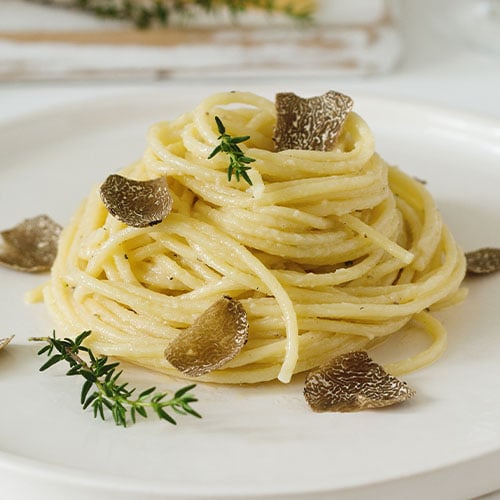
Truffle cream sauce is considered to be one of the more luxurious sauces to add to a menu. This creamy sauce has a distinct earthy flavor to it provided by the truffles in the recipe. Truffles are one of the most expensive types of mushrooms because of how difficult they are to find. In order to make the dish more affordable, ready-made truffles can be used instead, which will add that unique flavor without breaking the budget. But if you’re looking to add a sophisticated touch to your menu, offer your customers some grated truffles on top truffle cream sauce pasta.
- Best Pasta for Truffle Cream Sauce: Penne, Ravioli, Fettuccine, Tagliatelle, Orecchiette, Risotto
- What Goes With Truffle Cream Sauce? Shrimp, scallops, steak, chicken, game meats, mushrooms, onions
- What Wine Goes With Truffle Cream Sauce? Light- To Medium-Bodied Red Wine
- Recipes With Truffle Cream Sauce: Truffle risotto, Ravioli with truffle cream, Truffle cream salmon, Beef tenderloin in truffle sauce
How to Make Truffle Cream Sauce
Because raw truffles are expensive, most truffle cream pasta sauce recipes use ready-made truffle meal or truffle zest to get that earthy, warm flavor. You can also use truffle oil to bring out that musky earthiness. You’ll also need butter, parmesan cheese, and olive oil for the recipe.
- Boil your pasta first and save some of the pasta water before draining.
- Heat butter in a saucepan until melted.
- Add the ready-made truffle meal and reserved pasta water, stirring until incorporated.
- Return the cooked pasta to the pan and stir until coated.
- Stir in grated parmesan cheese before serving.
Types of Pasta Sauce Chart
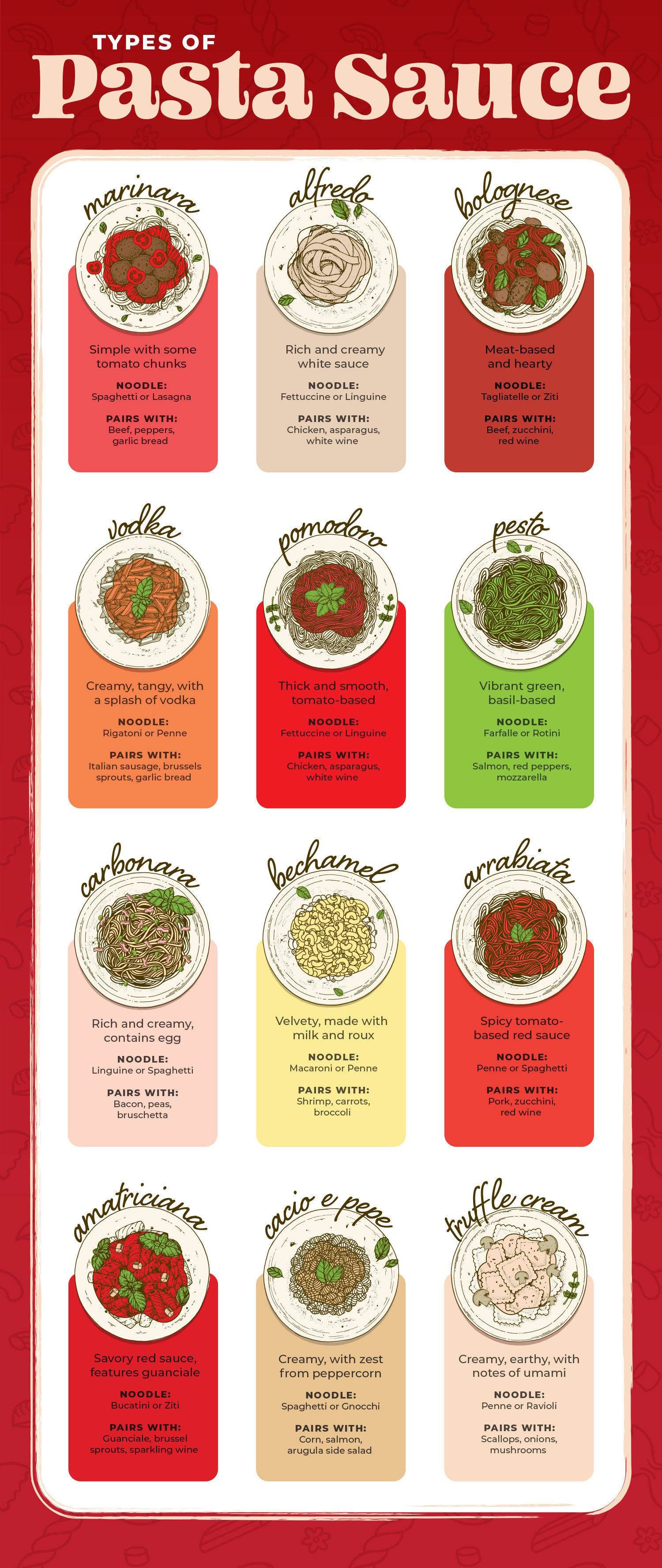 Printable Version
Printable Version
Back to Top
You may be surprised to learn that there are more types of spaghetti sauce than just simple tomato sauce. Use this pasta sauces list to give your menu a delicious boost and introduce new options to your guests.






